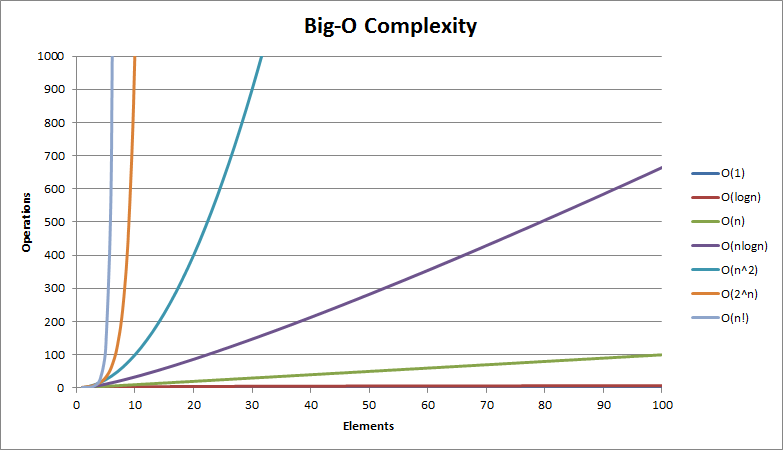Pair: Jerrad + Sacha
Data Structures & Algorithms, per: https://courses.thinkful.com/dsa-v1/checkpoint/3#assignment
Big-O Cheet Sheet: https://tf-assets-prod.s3.amazonaws.com/tf-curric/data-science/Thinksheet-BigO.pdf
To run any of these scripts, in terminal command line enter: node script-name.js
Time Complexity Analysis approach:
- Number of expressions, line-by-line, considered in isolation from other lines of code.
- Math expression, simplify it
- Replace numbers for constants (and constants are just 1)
- Identify the fastest growing term, typically some form of
n - Remove the constants from the fastest growing term
- Express this in Big O notation
v1. O(1). Constant time. Performing a .find() operation. It requires one action to get a result, regardless of the size of the input (the number of people).
v2. O(n). Linear time. Performing a for loop operation. As the number of people increases, the steps increase at the same rate.
O(1). Constant time because the number of operations doesn't change based on the input
O(n^2). Quadratic (Polynomial) time complexity. Because it's a nested for loop. For each n element in arr1 we have to perform k operations in arr2.
O(n). Linear time. We perform one operation per element in the array, so our operations grow at the same rate as the input.
O(n). Linear time. Same same. As array grows, number of operations grow in parallel. It's a for loop, innit.
O(n^2). Polynomial time. For each n element in i we have to perform another (k operation) in j.
O(n). Linear time. You take everything inside and you boil it down to what is growning fastest... the n of the for loop. It's printing out a custom sequence of specific numbers... looking at the numbers -- we console.log'd it ;P -- it appears to be the fibonacci sequence.
O(log n). Logarithmic time. Every iteration of the operation of search cuts the array in half, which is a characteristic of logarithmic algorithms. Conversely, every time you double n, the runtime only increases by one step. This is also referred to as a 'Binary Search' and a process of "Divide and Conquer".
For a physical demonstration of this search in action, checkout CS50 'Tearing up the Phone Book' demo
O(1). Constant time. Requires no iteration. Single operation to return an item in an array, with an additoinal randomization operation thrown in.
O(n). Linear time. Because there is a for loop with variable n within the condition, so as the input grows the number of operations performed by the for loop grow at the same rate. As to the purpose of the function, it's to identify prime numbers, as the function will return true only if two conditions are met: if n is a whole number that is only divisible by itself.
I have no friggin' idea.
Aside: Big-O Classifications chart
Chart: the different runtime complexities with relation to their input sizes...

Table: the number of operations required by different time complexities with inputs of size 10, 100, and 1000...
| Big-O Notation | n = 10 | n = 100 | n = 1000 |
|---|---|---|---|
| O(1) | 1 | 1 | 1 |
| O(log n) | 3 | 6 | 9 |
| O(n) | 10 | 100 | 1000 |
| O(n^2) | 100 | 10000 | 1000000 |
| O(2^n) | 1024 | 2^100 | 2^1000 |
O(1) constant-time.js
Constant time complexity is the "holy grail". No matter the size of your input, the algorithm will take the same amount of time to complete.
O(log n) logarithmic-time.js
Time increases with size of data, but not proportionately so (like linear time). Every time you double n, the runtime only increases one step. Conversely, it is also characteristic of logarithmic algorithms that they cut the problem size in half each round through. Same same but different, CS50 Phone Book demo
O(n) linear-time-sum.js / linear-time-find.js
Algorithms with linear time complexity have running times that are directly proportional to the size (n) of the input.
O(n^k) polynomial-time.js
An algorithm with polynomial time complexity has a running time that would be some input size n raised to some constant power k. The easiest way to understand polynomial time complexity is with nested loops.
O(2^n) exponential-time.js
No clue what the purpose of the function is for, even after it's explained to me. haha.